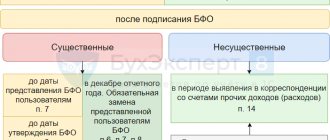Most often, organizations think about the need for certain documents at the beginning of the year: what applications to take from employees, how to draw up orders (instructions), approve regulations and coordinate documents. Let's talk about the forms of primary accounting documents for recording labor and its payment.
Unified forms for conducting personnel records management were approved by Resolution of the State Statistics Committee of Russia dated 01/05/2004 N 1 “On approval of unified forms of primary accounting documentation for recording labor and its payment” (hereinafter referred to as Resolution N 1).
According to clause 2 of the document, their use was mandatory. But on January 1, 2013, Federal Law No. 402-FZ of December 6, 2011 “On Accounting” (hereinafter referred to as Law No. 402-FZ) came into force. It does not contain requirements for the need to compile primary accounting documents according to unified forms.
Now, according to Part 4 of Art. 9 of Law N 402-FZ, the forms of primary accounting documents used by an organization (except for public sector organizations) must be determined by the head of the organization.
The possibility of independently developing forms of primary accounting documents was confirmed by Rostrud in Letters dated 02/14/2013 N PG/1487-6-1, dated 01/23/2013 N PG/10659-6-1, dated 01/09/2013 N 2-TZ. However, Law No. 402-FZ does not contain a ban on the use of unified forms, so they can still be used.
Thus, an organization can make one of the following decisions regarding the use of personnel records:
- continue to use unified forms without introducing anything new into them;
— refuse to use them, replacing them with newly developed ones;
— continue to use unified forms, making changes and/or additions to them that reflect the specifics of the organization’s work and relationships with staff.
Unified forms of primary accounting documents - what does this mean?
For many years, until 2013, only documents compiled according to specially approved forms could be used as primary documents for accounting and tax accounting purposes.
These forms are called unified. It was allowed to draw up in free form only those documents for which there was no unified form. With the entry into force of the Law “On Accounting” dated December 6, 2011 No. 402-FZ, economic entities received the right to develop document forms independently, subject to compliance with certain requirements for them.
However, many companies continue to use unified forms, because... they comply with all legal requirements. ConsultantPlus experts have collected all the forms into a single material. Get trial access to the system and go to Help information for free.
After this, most of the unified forms of primary documents became recommended, but some remained mandatory. We will talk about them further.
Required details
The list of mandatory details that the primary document must contain is established by paragraph 2 of Article 9 of the Law “On Accounting”:
- name of the document (form);
- date of document preparation;
- name of the organization on behalf of which the document was drawn up;
- content of a business transaction;
- business transaction meters (in physical and (or) monetary terms, indicating units of measurement);
- the names of the positions of the employees responsible for the execution of the business transaction and its registration and their personal signatures. In addition to the signatures of these persons, it is necessary to indicate their last names and initials, or other details that will help identify them.
In officially approved standard forms, all mandatory details are already provided.
If the accounting policy of an organization stipulates that unified forms are used as primary documents, but a form is not provided for some fact of economic life, the company can develop it independently.
There is no need to put a stamp on primary documents, since it is not a mandatory requirement. If the company uses standard forms of primary documents, in which a seal is already provided, then it is better to put it in order to fill out all the details of the document.
The types of electronic signatures used to sign accounting documents are established by federal accounting standards (Article 21 of the Law “On Accounting”. Such standards have not yet been adopted. Therefore, an organization can use any type of electronic signature provided for by the Federal Law of April 6, 2011. No. 63-FZ “On Electronic Signature" (hereinafter referred to as Law No. 63-FZ). Such clarifications are given in the letter of the Federal Tax Service of Russia dated May 19, 2016 No. SD-4-3/8904.
Currently, Law No. 63-FZ distinguishes three types of electronic signatures, which generally differ in the degree of security and complexity of obtaining:
- simple electronic signature;
- enhanced unqualified electronic signature;
- enhanced qualified electronic signature.
For accounting purposes, until a federal accounting standard has been adopted, electronic primary documents can be certified with any of the three types of signatures provided for by Law No. 63-FZ.
There are restrictions for tax accounting. Let's start with the last one on the list - enhanced qualified electronic signature. Information signed with such a signature is recognized as an electronic document equivalent to a paper document signed with a handwritten signature (Clause 1, Article 6 of Law No. 63-FZ).
In accordance with Article 252 of the Tax Code, expenses taken into account for profit tax purposes must be documented, in particular, by primary accounting documents (Article 313 of the Tax Code of the Russian Federation). The form of the primary document must contain the mandatory details established by paragraph 2 of Article 9 of the Law “On Accounting”. One of the mandatory details of the primary accounting document is the personal signature of the persons responsible for processing the transaction. The primary document compiled in electronic form is signed with an electronic signature.
This means that the “primary document”, drawn up in electronic form and signed with a qualified electronic signature, can confirm income tax expenses.
Electronic documents can also be signed with a simple electronic signature or an enhanced unqualified electronic signature, if this is provided for by the agreement between the participants in the electronic interaction. But in order to write off tax expenses on the basis of a primary document signed with a simple or unqualified signature, the agreement with the counterparty must stipulate the procedure for verifying the signature.
Regarding the signing of electronic invoices (clause 6 of Article 169 of the Tax Code of the Russian Federation), as well as when carrying out electronic interaction with tax authorities, it is necessary to use only an enhanced qualified electronic signature.
What unified forms of primary accounting documentation are mandatory?
Forms of primary documentation established by authorized bodies in accordance with and on the basis of other federal laws continue to be mandatory (see letter of the Ministry of Finance of Russia dated March 6, 2013 No. 03-03-06/1/6700). For example this:
- Cash documents from the album of unified forms, approved by Decree of the State Statistics Committee of the Russian Federation dated August 18, 1998 No. 88 (information of the Ministry of Finance of Russia No. PZ-10/2012, letter of the Ministry of Finance of Russia dated February 28, 2013 No. 03-03-06/1/5971).
- Consignment note in the form from Appendix 4 to the Rules for the transportation of goods by road, approved by Decree of the Government of the Russian Federation dated 04/15/2011 No. 272 (this follows from letters of the Ministry of Finance of Russia dated 09/06/2016 No. 03-03-06/1/52112, dated 07/20/2015 No. 03-03-06/1/41407, Federal Tax Service of the Russian Federation dated May 17, 2016 No. AS-4-15/ [email protected] )..
Thus, the mandatory use of unified forms applies not only to cash documents, but also to the waybill.
Find out how to properly prepare primary documents in ConsultantPlus. If you do not have access to the K+ system, get a trial online access for free.
You can find a transport bill of lading in the article “Confirmation of transport costs - with what documents?” or in the material “Transportation costs are confirmed by only one document.”
The forms established for state employees are also mandatory. They can be found in the Order of the Ministry of Finance dated March 30, 2015 No. 52n on the approval of forms of primary documents and accounting registers of government agencies and public sector employees and instructions for their use.
Relevance of document management
The office management service, which strives for the status of a document management service and the main center of competence in this area, can now consider the legislative “strangeness” and this unexpected “democraticism” in the issue of using unified forms of documents in a positive aspect
.
Unification of an organization's documents in composition and form in order to optimize document flow and document collection can become a priority function of the office management service: it should be included in the regulations on this service and reflected in the relevant work plans.
GOST R ISO 15489-1-2007 recommends that the rules for creating documents and their metadata, the rules for including documents in information systems should be implemented in all procedures governing all business processes that require proof of actions (clause 7.1). The records management service can initiate (even prepare a short draft based on GOST R ISO 15489) the development of a Document Management Policy with the distribution of areas of responsibility of departments and officials
for documents reflecting one or another “business process” of the organization.
The responsibility of officials for the creation, use, storage and destruction of documents within the framework of their assigned duties should be reflected in the Regulations on departments and job descriptions
, and also regulated in
the Regulations on the system of delegation of powers
. The concept of document management involves establishing flowcharts for each process (or activity area):
- types and varieties of documents created,
- forms of their presentation,
- shelf life,
- signing authority,
- responsibility for storage, destruction, etc.
To fulfill this requirement, the office management service must become an authority for mandatory approval.
all organizational and administrative documents in order to be able to optimize the forms of documents, ensure their uniformity and compliance with the corporate style, develop them as “input” forms into information systems, etc.
By performing the function of unifying document forms, the office management service actually increases the efficiency of the organization. The company's top management needs to explain
that drawing up a document according to a unified standard form (template) takes
3–5 times less time
than drawing up an individual document in free form, as the executive employee is used to.
And finally, the office management service, the accounting department, and all departments of the organization need to remember that the unification of document forms consists of:
- in the selection and consolidation (taking into account the material medium) of indicators and details that best
reflect the purpose of creating the document, ensure its legal force, and also - in establishing uniform requirements for their preparation and execution,
- development and application of electronic templates for draft documents based on their approved standard unified forms.
The main tools for document unification and management remain:
- Classifier of unified forms of documents;
- Sheet of unified forms of documents
of the organization (or Sheet of applicable document forms); - Album of unified document forms
(or Album of document forms approved and used in the organization).
The Classifier, Sheet and Album of Forms can be maintained both electronically and in paper form
.
Since documents are subject to updating and fix the “version” of the forms used, the Album must provide for accounting of both existing forms and canceled ones
. If the Album and the Timesheet are maintained in electronic form, then they can have 2 parts: current and “archive”.
When maintaining electronically, it is also necessary to provide for the form of presentation of the original document. If a document must additionally be printed as a paper copy of an electronic original or created exclusively in paper form (for example, an order for the main activity or a personal card of form No. T-2), then the Album of Forms includes printouts of document forms created electronically and approved standard forms of paper documents.
To implement the function of unifying document forms, it is advisable for office management service employees to undergo advanced training and update their professional knowledge taking into account the requirements of previously existing standards (for example, GOST 6.10.5-87 “Unified documentation systems. Requirements for the construction of a sample form”) and modern standards for document management.
Minimum program
Where to start, even if the organization missed the deadline for approving primary accounting documents (from January 1)? How to interact with accounting? Of course, accounting should
initiate the issuance of an order approving the forms of primary accounting documents as quickly as possible: submit a draft order and these forms. We recommend taking as a basis previously used forms from albums approved by the Decree of the State Statistics Committee of Russia, for example, dated January 5, 2004 No. 1 on the approval of forms for recording labor and its payment.
If the shape doesn't change
the office management service
on it by order of the first manager.
If the form is designed by the organization independently
, then it must have the same approval stamp on it. See Example 1.
Example 1. Stamp on the document form approved by order
But in some organizations, an order can be issued by different persons (within the framework of the delegation of authority), then the author of this document should be clarified:
Example 2. Stamp on the document form approved by order
So, let us emphasize that, within the framework of the minimum program, it is necessary to approve the standard forms of primary accounting documents used in the organization by order (i.e., you can do without compiling an Album and a Sheet of Forms).
There are different judgments regarding the choice of the type of order to approve document forms. But best practices show that orders for administrative and economic (administrative and organizational) activities
, which are administrative documents of operational validity and have
a 5-year shelf life
(Example 3).
When preparing a draft order, its text must provide for:
- when the approved forms are put into effect:
immediately or the IT department will need time to set up these forms in the information system; - which unit or official will be entrusted with the function of methodological guidance in the application of these forms
(not only primary accounting documents, but also all unified forms); - identification of approved forms
, for example, using indexes that have already been assigned to standard forms at the national level, or using codes according to a classifier of document forms that the organization develops independently.
Example 3. Order on approval of the forms of primary accounting documents used in the organization
In Example 3, note the approved form codes. They are assigned according to the Document Form Classifier
, for the development and maintenance of which
the office management service is responsible
.
It is especially necessary for identifying electronic documents in information systems
.
You can start developing classifiers by creating the simplest reference book - a classifier of document types, which will be replenished with them as the unified forms are approved. Initially, this will be an open list of document types, structured by degree of importance or by the documents’ affiliation with the documentation system/subsystem:
Example 4. Classifier of document types
Next, the classifier of document types can be developed and turned into a Classifier of Unified Forms of Documents (hereinafter referred to as the Classifier of Forms), identifying documents that reflect a specific process or area of activity:
Example 5. Classifier of document forms (identification of staffing form)
This is how the staffing table form code can be generated in the classifier:
The development of a coding structure for document forms is important. We recommend that you include an identifier of the date of its approval and/or entry into force (month, year) in the form code:
Example 6. Structure of the form code based on the date of approval or implementation
The code must be placed on each document form. It is recommended to additionally put on the forms the corresponding codes of documents according to OKUD (if the organization develops unified forms based on albums of document forms included in OKUD).
Example 7. The code of the approved staffing form according to the Classifier of document forms of the organization (indicating the code according to OKUD) is placed below the approval stamp
In the process of maintaining unified forms of organization documents, the algorithm for their approval is specified. It is important that the order establishes responsibility, the deadline for introducing the form, the procedure for communicating it to the organization’s employees, i.e. specific instructions, which is impossible to do when approving the form only with the signature of the manager on the approval stamp. So, the algorithm for approving a new form could be like this:
- The structural unit that owns a specific business process (the initiator) develops a draft form or its new version (if changes are made to the form, then it is not them that are approved, but a completely new version of the form with current changes already made by the developers). It is important that the developer decides on the form of submission of documents (electronic or paper original, the possibility of making and using a paper or electronic copy), which will be compiled and executed according to this form.
- All departments interested in using the form, including the office management service, agree on its draft. At the time of approval, the office management service may include a draft form code in the draft order. It is important that the IT department, during the approval process, makes the necessary settings in the information system so that a document form used, for example, exclusively in electronic form, can actually be used from the moment it is approved and put into effect.
- The initiating unit draws up a draft order for its approval and implementation, formulates the procedure for distributing the order and form (or notification of its approval / change).
- The order is signed by the head of the organization.
- Office management service (if it has developed and maintains a Classifier, Timesheet and Album of Forms):
- enters the approved form into the Album (in its current part), and transfers the canceled form to its “archive” part;
- enters a new one (or confirms the code of the current form, changing only the data about the month and year of approval), and makes the appropriate entries in the Form Sheet and Classifier.
- Then the order and form are sent out (or published in the corporate information system or on the internal portal (intraweb)).
Example 8. The administrative part of the text of the order approving a new version of a previously approved form
Maximum program
So, the office management service needs to secure for itself the function of unifying the composition and content of documents used in the organization.
To identify unified forms of documents, it is necessary, together with other infrastructure departments (personnel, accounting, planning and financial department), to create a system of classifiers and reference books. On their basis, the organizational and functional architectures of the information systems used will be built and their interaction will be ensured.
It is also necessary to resolve issues of training or advanced training of office management service specialists, since in organizations there are practically no specialists who would professionally perform all types of work in the process of unifying forms (especially for the purpose of creating documents or their projects mainly (or exclusively) in electronic form).
And finally, we should remember the meaning, form and order of registration and maintenance of the Timesheet, Album and Classifier of document forms
, as well as their relationship.
Table of unified forms of documents
is a normative document and is a list of document forms approved and permitted for use in the organization. It reinforces the main stages of their preparation, movement and use. The main purpose of maintaining the Timesheet is to classify and systematize the forms of documents used in accordance with the functions, tasks or areas of activity of the organization and to consolidate uniformity in working with them (primarily uniform operations of approval and approval).
In the context of using information systems, a properly developed Timesheet can serve as an organizational basis for:
- typification of document movement routes and document flows;
- formation of functional document complexes necessary and sufficient for the implementation of functions and tasks, their unification, management and effective implementation of the “linked documents” mechanism in the system.
Next, we will recommend a list of table columns, and you will see for yourself the relevance of this document management tool, especially in the process of developing or modernizing the EDMS.
Album of unified forms of organization documents
must be a collection of standardized forms of documents, compiled and executed in the manner established by the organization. It should include absolutely all approved unified forms of documents, even if only an electronic form of the document is provided:
- Mainly paper standard forms of documents (as originals) are submitted for approval and included in the Album,
- for electronic original documents, it is advisable to include: their printed (visualized) forms,
- and if paper copies are to be made, then printable forms (printouts on paper).
The main purpose of maintaining an Album of Forms is to consolidate the results of the unification of documents and to design an array of unified forms included in the Table and identified in the Classifier of Forms.
The Timesheet and Album are considered as local regulations of the organization, since the forms of these documents, as well as standard unified forms to be included in them, are approved by order of the first head of the organization. Employees of the organization should be prohibited from drawing up documents using forms not included in the Timesheet and Album. Then this system of applying unified forms will start working!
Form of the report card
The form of the Report Card was developed as part of an album of posters and forms of the main organizational and administrative documents of the State System of Documentation Support for Management (GSDOU; M., 1991). It was a table of 19 columns, on the top field of which it was supposed to be marked with approval by the head of the organization at the moment when the entire table, as a result of extensive organizational design work, would be filled out, all used forms of documents would be identified and classified and the main operations of their processing would be established.
The modern approach to the Report Card is different. As business processes are regulated, flowcharts are developed, all document flows and their composition are identified, the Timesheet is replenished, documents and information are included in it in the process of analyzing the “document-oriented component” of any organizational function, i.e. The timesheet is subject to constant maintenance.
Therefore, in order to record the results of such document management, the form of the Timesheet must first be developed and approved, and the unit that will maintain it must be appointed.
The timesheet as a document must have a title page, table of contents/table of contents, a list of abbreviations and symbols, and the actual text (i.e., a list of forms presented in tabular form). It is possible to compile an alphabetical index for the Table for easy searching of document forms (can be developed on the basis of a classifier of document types).
When developing a table table you can use:
- main table of the Form Classifier;
- business process classifier, if the organization has one;
- a classifier of issues and areas of activity that the records management service uses for preliminary review of documents.
In any case, the Table must have its own main table, i.e. list of sections that may reflect either the areas of activity of the organization or the names of structural divisions:
Example 9. Main tables of the Table of Document Forms
Within each section of the Table, documents can be systematized:
- alphabetically by the name of the type of document (for example, act, application, order, etc.) or
- according to the degree of significance of the documents and their interrelation (first organizational documents, then administrative, reference and informational, planning, etc.).
The table columns of the Table can be as follows:
- document form code (according to the Classifier of Organization Forms);
- name of the unified form of the document;
- form code according to OKUD, according to the industry classifier or an additional document index (for example, the personal card form code according to OKUD is 0301002, and the index is T-2; the employee’s personal account according to OKUD 0301012 has the index T-54);
- person responsible for preparation and registration (this may be a unit, the head of a unit, or an authorized employee of the unit);
- preparation time (in working days);
- frequency of preparation/publication;
- project approval (internal or external; “live” or electronic; if electronic, then what type of electronic signature is used);
- original presentation form (paper/electronic);
- composition of the certificate: signature: this column indicates the name of the signatory’s position and indicates “handwritten” or the type of electronic signature (the positions of possible signatories are indicated based on the system of delegation of authority in force in the organization);
- approval stamp;
- seal: which one can be affixed - “main” or special;
- responsible structural unit or localization in the information system,
Thus, the columns of the Table of the Table should reflect modern document management algorithms in accordance with GOST R ISO 15489–1–2007, which the office management service must master within the framework of the concept of document management and in the context of the implementation of information systems.
What does “album of unified forms of primary accounting documentation” mean (examples)
An album of unified forms is usually called the so-called thematic selection of document forms. So, there are accounting albums:
- personnel, working hours and settlements with personnel for wages;
- cash transactions;
- trading operations;
- fixed assets and intangible assets;
- materials;
- products, inventory items in storage areas;
- inventory results;
- works in capital construction and repair and construction work, etc.
List of primary documents for individual entrepreneurs using the simplified tax system
The choice of taxation regime affects the composition and completeness of accounting in general and the list of primary documents used in particular. An individual entrepreneur who has chosen the simplified tax system “income” must take care of correctly filling out the Book of Income and Expenses (in the revenue part). Accordingly, data for KUDiR should be taken from primary documents:
- certificates of completed work confirming the provision of services to customers;
- invoices for the transfer of products.
Both of the above-mentioned documents confirm the fact of completion of the transaction for the sale of products or provision of services. Confirmation of payment by the customer or buyer is an extract from the current account received by the individual entrepreneur at the bank. When receiving cash from the customer, the following types of primary documents are drawn up:
- cash receipt order;
- Z-report (when using CCP).
If the tax base of an individual entrepreneur using the simplified tax system is “income reduced by the amount of expenses,” the list of primary documents expands. The entrepreneur will have to record in chronological order the expenses that reduce the income side of KUDiR. The following primary documents support these expenses:
- expense reports;
- expense cash orders;
- acts of write-off of materials;
- sales receipts for the purchase of goods and materials;
- pay slips for settlements with employees;
- other documents.
In paragraph 1 of Art. 346.16 of the Tax Code of the Russian Federation specifies a list of expenses that an individual entrepreneur has the right to include in KUDiR to reduce the taxable base under the simplified tax system.
Unified forms of personnel documents (timesheets, statements, etc.)
Unified forms of personnel documents were approved by Decree of the State Statistics Committee of the Russian Federation dated January 5, 2004 No. 1. Conventionally, they can be divided into 2 groups:
- Documents directly related to personnel records - from hiring to dismissal:
- order (instruction) on hiring;
Cm. .
- employee personal card;
See “Unified form No. T-2 - form and sample filling” .
- staffing schedule;
See “Unified Form No. T-3 - Staffing (form)” .
- order (instruction) on granting leave to the employee;
Cm. .
- vacation schedule;
See "Unified Form No. T-7 - Vacation Schedule" .
- dismissal order, etc.
See “Unified form No. T-8 - form and sample filling” .
- Documents reflecting data for settlements with personnel:
- time sheets according to forms No. T-12 and T-13;
See “Unified Form No. T-12 - Form and Sample” and “Unified Form No. T-13 - Form and Sample” .
- salary slips: payroll, settlement and payroll;
See “Unified Form No. T-49 - Form and Sample” , “Unified Form No. T-51 - Calculation Sheet” and .
- personal account, etc.
See “Unified Form No. T-54 - Personal Account” .
A little about the design of the primary
When filling out primary accounting documents, care must be taken, and the information entered must be clear. You can fill out registers manually or typewritten. In the primary it is important to reflect the following points:
- the name of the document allowing its identification;
- Date of preparation;
- all necessary details (name of the economic entity, its TIN, OGRN or OGRNIP, signatures of authorized persons, etc.);
- calculation data in words and figures, etc.
Incorrect completion of primary accounting documents becomes the reason for the exclusion of this business transaction from the tax base when audited by regulatory authorities.
Any corrections in the primary account are possible before the information from these registers is reflected in the accounting records.
Unified documentation for recording cash transactions
Again, these forms are required. This means that you are required to draw up cash documents strictly according to the forms that are present in the album approved by Decree of the State Statistics Committee of the Russian Federation dated August 18, 1998 No. 88. These are well-known to everyone:
- cash receipt order;
See “Unified form No. KO-1 - cash receipt order” .
- account cash warrant;
See "Unified Form No. KO-2 - Cash Order" .
- cash book, etc.
See “Unified Form No. KO-4 - Cash Book”
Look for other documents on the cash register on our website in the section “Online cash registers KKT KKM”.
And you will find the main forms of primary accounting documentation for other areas and objects in the section “Accounting > Accounting Documents”.
NOTE! On our website there are completed samples for all documents, which can not only be viewed on the website, but also downloaded in Word or Excel formats.
As stated by the “primary”
Primary documents are drawn up according to forms determined by the manager.
This is done on the recommendation of the official responsible for maintaining accounting records. This is stated in Part 4 of Article 9 of Law No. 402-FZ. Financiers clarify: the manager not only approves the forms, but also determines the composition of the “primary” form, as well as the list of persons who have the right to sign them (information No. PZ-10/2012).
In practice, the forms are developed by the accounting department, after which they are approved. For this purpose, separate orders or instructions are issued within the framework of the accounting policy, or an independent internal document is issued dedicated to the organization of primary accounting and documentation of the facts of economic life,
It is worth noting that the accounting policy must include as an appendix a complete list of all primary accounting documents that will be used, and provide their samples with explanations for filling them out.







